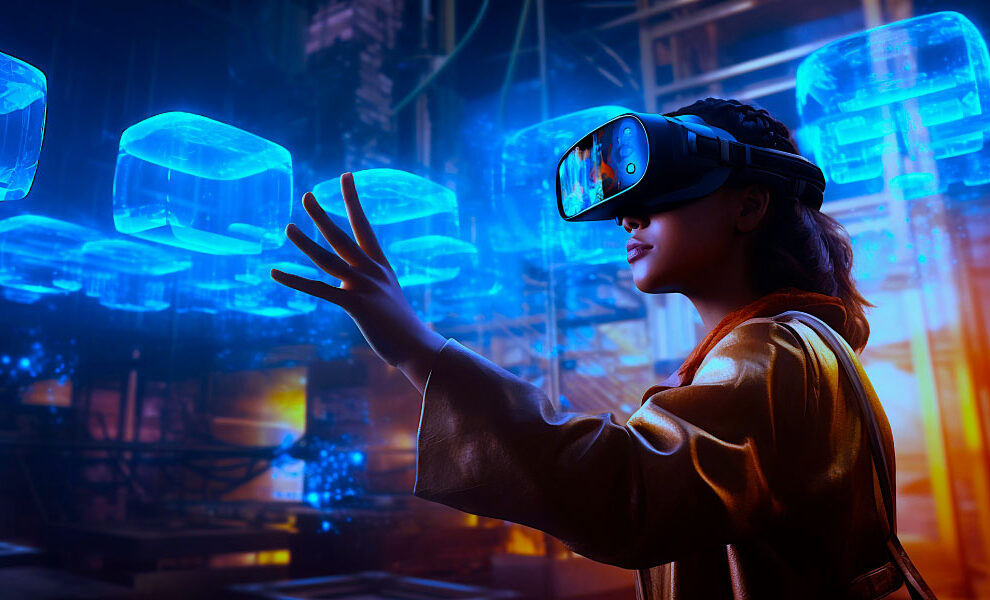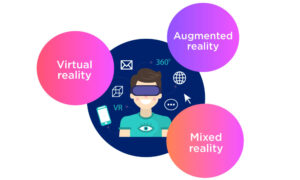Imagine stepping into a world where digital overlays bring your surroundings to life, blurring the line between real and virtual. That’s the power of extended reality (XR). This blog discusses the meaning, components, pros, cons, and future of XR technology.
Let’s dive into how XR, blending VR, AR, and MR, is revolutionizing our interactions with technology.
Exploring the World of Extended Reality (XR) Technology
Any technology that modifies reality by incorporating digital aspects into the physical or real-world environment to any degree is referred to as extended reality (XR). This includes, but is not limited to, virtual reality (VR), mixed reality (MR), and augmented reality (AR).
XR will also include any new technology that combines the virtual and real worlds. Any variable—any letter of the alphabet—that may be utilized in the future for such technologies is represented by the “X” in XR.
As a result, the phrase “extended reality” does not relate to any technology; rather, it encompasses any current or potential future technologies that modify reality, either by fusing the digital and physical worlds or by producing a completely virtual environment.
3 Components of Extended Reality (XR Technology)
1. Virtual reality
Users immerse themselves in a virtual world using virtual reality. VR users usually put on a headset that immerses them in a virtual world; one minute they are in a real place, and the next they are in a synthetic one.
These limits are pushed by the most recent VR technology, which makes these environments appear and act more like the real world. Support for other senses, including touch, sound, and smell, is also being added.
VR allows shops to test virtual displays before deciding on a real one, designers and clients to study building projects to approve details before construction begins, and gamers to immerse themselves completely in a video game.
2. Augmented reality
Overlaying a generated picture on top of the actual environment is known as augmented reality. As players explore their areas, computer-rendered monsters appear on sidewalks and lawns in the mobile game Pokémon GO, which is credited with popularizing augmented reality.
Users may view AR images on smartphones, tablets, and other devices, offering them a brand-new interactive experience. For instance, augmented reality can help with navigation. With virtual arrows telling the driver precisely where to turn, a windshield may overlay directions over a person’s perspective of the road instead of using a 2D map.
3. Mixed reality
Through the smooth blending of generated images and the actual world, mixed reality produces an environment where users may interact directly with both the digital and physical worlds.
With MR, virtual and real objects coexist and are seen on the same screen. Users may interact with digital items by moving them about or putting them in the real world, and they can experience MR environments via a headset, phone, or tablet.
Two varieties of MR exist:
- Blending virtual and real-world elements together: For example, a person wearing a VR headset may observe the actual world through cameras while virtual objects are seamlessly incorporated into the scene.
- Incorporating real-world elements into virtual worlds: For instance, a camera view of a VR player integrated into the virtual environment, similar to seeing a VR gamer engage in gameplay.
Elements You Must Know About XR Technology
Pros
- Safe experiential learning: XR technology offers a secure environment where students can take chances and grow from their errors.
- Practice realistic hard and soft skills: XR technology helps with the development of soft skills like empathy and communication as well as hard skills like using and maintaining machinery.
- Easy to scale and reuse: XR training is easily scalable throughout a company, and its content may be reused as needed.
- Important criteria for calculating ROI: XR aids in measuring quantifiable ROI and knowledge retention.
Cons
- High initial equipment and development costs: Compared to conventional learning approaches, XR technology may have higher initial costs. Internal resource use and pilot initiatives are examples of mitigation techniques.
- Health concerns and adverse effects: XR technology may result in headaches, eye strain, and nausea. To mitigate these hazards, alternative access choices ought to be made available.
- Technical developments and sporadic updates: XR technology is susceptible to sporadic software and hardware upgrades. Regardless of location, investing in an XR Resource Sharing (XRS) can assist in delivering updated content.
Mesmerizing Future of Extended Reality
With its combination of Virtual Reality (VR), Augmented Reality (AR), and Mixed Reality (MR), Extended Reality (XR) has an exciting future. The goal of XR technology is to create immersive, organic, and interactive experiences by fusing the digital and real worlds. VR immerses users in completely digital worlds, giving virtual travel, gaming, and education an incredibly lifelike experience.
AR, on the other hand, allows applications such as smart glasses that offer real-time navigation or product information by superimposing digital elements onto our physical world. By enabling smooth interaction between virtual and real-world items, MR goes one step further and creates new opportunities in industries like education, healthcare, and distant work.
With lighter headsets, better visuals, and quicker connections, XR technology is making devices more accessible and comfortable. By providing faster data processing and more individualized experiences, 5G and AI are also improving XR. Retail, corporate training, and the entertainment sector are just a few of the industries that are anticipated to gain greatly from XR.
Even though there are still obstacles to overcome, like privacy issues and expenses, XR has the exciting and captivating potential to transform our daily lives, workplaces, and entertainment. XR has the potential to completely change how we engage with the digital environment in the years to come.
Be Ahead of Time with XR Technology!
Extended reality is redefining reality, with transformative potential across industries—from immersive gaming and training to virtual tourism and remote work. As XR advances, we’re set for a future where digital and physical worlds blend seamlessly, making life richer, more interactive, and endlessly fascinating.
For more tech-related content and information, keep visiting us at HitechNectar.
Recommended For You:
Data Visualization in AR and VR
OCULUS GO: VR REVIEW | A Huge Step in Comfort and Ergonomics



